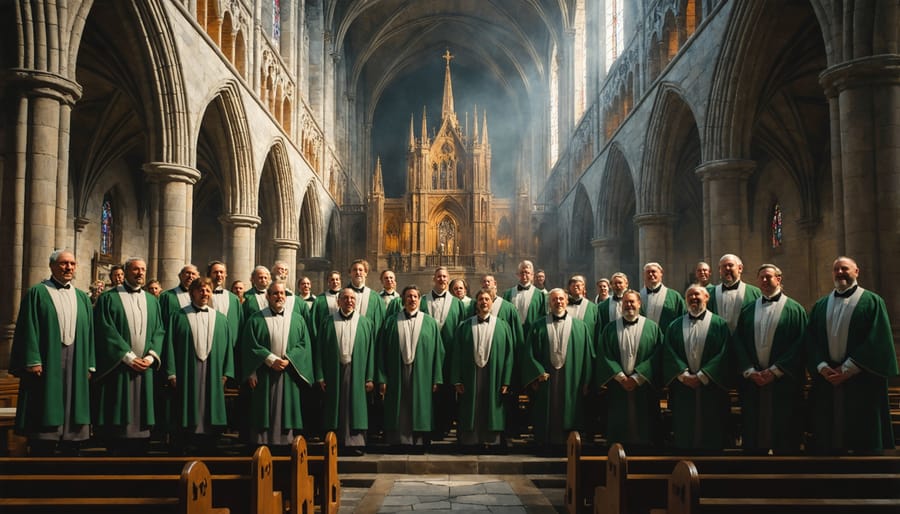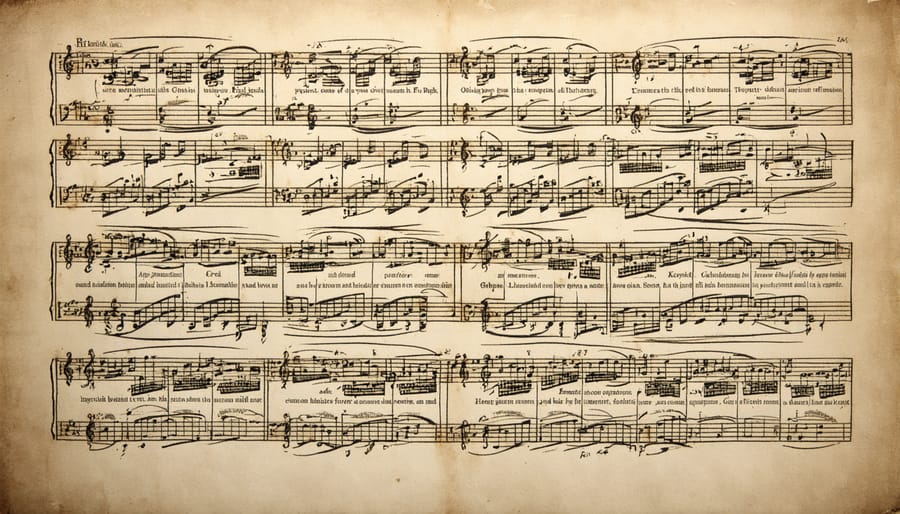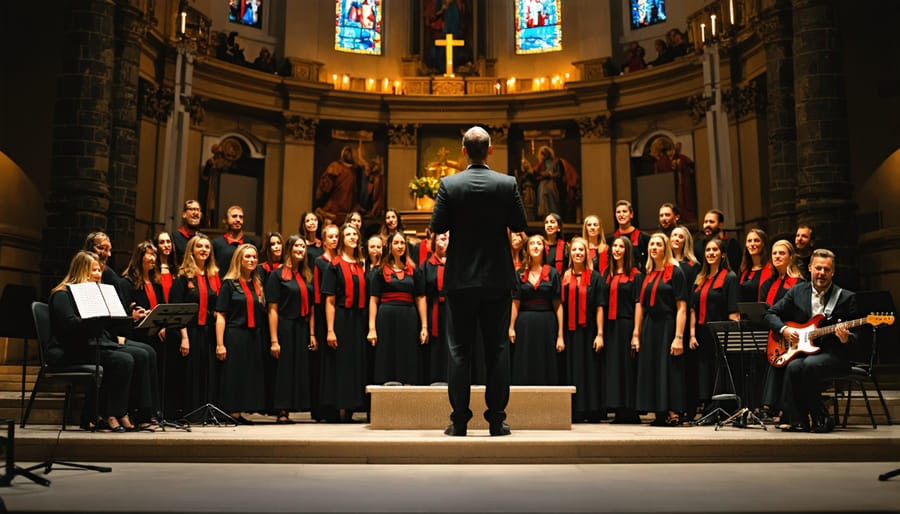Sacred music transcends mere melody and rhythm, serving as a divine bridge between heaven and earth in Christian worship. Unlike sacred and secular music, which differ in their fundamental purpose, sacred music carries a profound spiritual mission: to glorify God and uplift the souls of believers. Throughout centuries of Christian tradition, this holy form of musical expression has remained a cornerstone of worship, prayer, and spiritual communion. Whether echoing through ancient cathedral halls or resonating in modern worship services, sacred music embodies the reverent offering of our hearts to God, expressing the deepest longings of faith through carefully chosen words and melodies. Its power lies not just in its artistic beauty, but in its ability to create a sacred space where believers can encounter the Divine presence and experience the transformative power of worship.
The Divine Purpose of Sacred Music
Biblical Foundations of Sacred Music
The Bible provides numerous examples of music’s sacred role in worship, establishing a divine foundation for sacred music that continues to guide Christian worship today. In the Old Testament, we find King David organizing musicians and singers for temple worship, demonstrating the intentional use of music to glorify God. The Psalms, many of which were written as songs, serve as a testament to music’s power in expressing praise, lament, and spiritual truth.
Scripture repeatedly encourages musical worship, as seen in verses like Psalm 150, which calls for praise with various instruments and dancing, and Colossians 3:16, which instructs believers to “sing psalms, hymns, and spiritual songs with gratitude in your hearts to God.” These biblical foundations reveal that sacred music isn’t merely entertainment but a divine appointment for worship.
The purpose of sacred music, as shown throughout Scripture, encompasses several aspects: praising God, teaching spiritual truths, encouraging believers, and expressing the heart’s devotion to God. This biblical framework continues to shape how we understand and approach sacred music in contemporary Christian worship, reminding us that musical worship is both a privilege and a responsibility given by God.
Sacred Music as a Bridge to Heaven
Sacred music serves as a divine conduit, creating a spiritual bridge between earth and heaven that allows worshippers to draw closer to God. As Scripture tells us in Psalm 22:3, God inhabits the praises of His people, and through sacred music, we create a sacred space where His presence can dwell among us.
When we engage with sacred music, whether through singing hymns, listening to worship anthems, or participating in liturgical chants, we enter into a unique spiritual dimension. This musical connection helps lift our hearts and minds above earthly concerns, allowing us to focus entirely on God’s majesty and glory.
Sacred music accomplishes this heavenly connection in multiple ways. Its carefully chosen lyrics often draw directly from Scripture or express deep theological truths. The melodies and harmonies are crafted to evoke a sense of reverence and awe, while the rhythms and musical structures help create an atmosphere conducive to worship and contemplation.
Just as Jacob’s ladder in Genesis provided a connection between heaven and earth, sacred music creates a spiritual pathway that enables believers to experience a foretaste of heavenly worship while still on earth.

Characteristics of Sacred Music

Musical Elements
Sacred music embodies distinct musical elements that work together to create an atmosphere of reverence and worship. These elements, deeply rooted in sacred tradition in worship, serve to elevate the spiritual experience and draw believers closer to God.
The melody in sacred music often features gradual progressions and memorable phrases that facilitate congregational participation. These melodic lines typically avoid excessive ornamentation, focusing instead on clarity and accessibility. Harmonies tend to be rich and contemplative, employing traditional chord progressions that create a sense of stability and reverence.
Rhythm in sacred music generally maintains a steady, dignified pace that allows for reflection and meditation. Unlike secular music’s often complex rhythmic patterns, sacred compositions usually feature measured tempos that support communal singing and prayer.
The use of specific instruments also contributes to the sacred character of the music. Organs, with their majestic sound and ability to sustain notes, have long been associated with Christian worship. Traditional sacred music may also incorporate bells, choirs, and acoustic instruments that produce pure, clear tones.
Dynamic contrasts in sacred music are typically employed thoughtfully, moving between soft, contemplative passages and powerful crescendos that symbolize divine glory. These musical elements work together to create an environment that encourages worship, reflection, and spiritual connection.
Lyrical Content
The lyrical content of sacred music serves as a powerful vehicle for expressing faith, worship, and biblical truth. Drawing directly from Scripture, sacred lyrics often incorporate psalms, hymns, and spiritual songs as mentioned in Colossians 3:16, which instructs believers to “let the message of Christ dwell among you richly.” These texts typically focus on praising God, declaring His attributes, and sharing the gospel message.
Sacred lyrics are distinguished by their theological depth and spiritual purpose. Whether through traditional hymns that expound on doctrine or contemporary worship songs that express personal devotion, the words are carefully chosen to align with biblical teaching. Many sacred compositions incorporate direct Bible quotations or paraphrase scriptural passages, making them valuable tools for teaching and memorizing God’s Word.
The text often follows specific patterns that enhance their spiritual impact. This might include call-and-response formats that encourage congregational participation, repetitive phrases that reinforce key truths, or progressive narratives that tell stories of faith. Additionally, sacred lyrics frequently employ rich symbolism and metaphors drawn from Scripture, helping worshippers connect deeply with spiritual concepts.
Most importantly, sacred lyrics are meant to direct attention toward God rather than human experience alone. While they may describe personal feelings or experiences, their ultimate purpose is to glorify God and nurture spiritual growth within the community of believers.
Sacred Music in Christian Worship Today
Traditional Sacred Music
Traditional sacred music has been a cornerstone of Christian worship for centuries, carrying forward the timeless expressions of faith from generation to generation. From Gregorian chants that echo through ancient cathedral halls to the majestic compositions of Bach and Handel, these musical treasures continue to inspire and uplift believers today.
Throughout history, the Church has preserved sacred music as a vital part of its liturgical heritage. The ancient psalms, which formed the foundation of early Christian worship, remain central to many denominations’ musical traditions. These enduring melodies and texts serve as a bridge connecting modern worshippers to the faithful who came before them.
Many traditional sacred works were specifically composed for worship services, with careful attention to biblical texts and theological meaning. The great Mass settings, oratorios, and hymns of previous centuries continue to be performed and cherished, not merely as historical artifacts, but as living expressions of faith that speak to contemporary hearts.
This musical legacy reminds us that while worship styles may evolve, the essence of sacred music – its focus on glorifying God and edifying believers – remains unchanged. As we sing these time-honored songs, we join our voices with countless believers across the ages in a beautiful tapestry of praise.
Contemporary Sacred Music
In the modern era, sacred music continues to evolve while maintaining its spiritual essence. Contemporary Christian artists and worship leaders have embraced new musical styles and instruments, creating fresh expressions of sacred worship that resonate with today’s believers. These modern interpretations range from contemplative acoustic arrangements to full-scale worship productions incorporating digital instruments and technology.
What makes contemporary sacred music unique is its ability to bridge traditional spiritual themes with current musical preferences. Modern worship songs often feature accessible lyrics that speak directly to personal relationships with God while maintaining reverent themes of praise, thanksgiving, and devotion. Artists like Chris Tomlin, Hillsong Worship, and Matt Redman have contributed significantly to this evolution, creating songs that have become staples in churches worldwide.
Despite its contemporary sound, modern sacred music remains focused on its primary purpose: leading people into God’s presence and facilitating spiritual connection. Many churches now embrace both traditional hymns and contemporary worship songs, recognizing that sacred music’s power lies not in its style but in its ability to direct hearts toward heaven.
Blending Traditions
In today’s diverse Christian landscape, churches are discovering beautiful ways to blend different sacred music traditions while maintaining their spiritual essence. Many congregations now embrace a harmonious mix of traditional hymns and contemporary worship songs, recognizing that God can be glorified through various musical expressions.
This integration often manifests in creative arrangements where ancient hymns are given modern instrumentation while preserving their profound theological lyrics. For example, some churches alternate between traditional choir performances and contemporary worship bands, allowing multiple generations to connect with God through familiar musical languages.
The blending process requires wisdom and sensitivity. Successful churches often introduce changes gradually, educating their congregation about the value of different musical traditions while emphasizing that all forms can be sacred when offered with genuine hearts of worship. As Scripture reminds us in Psalm 96:1, “Sing to the Lord a new song; sing to the Lord, all the earth.”
Some congregations incorporate cultural elements from their community, weaving together gospel, Latin American, African, or Asian worship styles with traditional Western hymns. This multicultural approach reflects the divine tapestry of God’s kingdom and helps create an inclusive worship environment where all members can authentically express their faith.
The key to successful blending lies in maintaining focus on worship’s primary purpose: glorifying God and edifying the congregation, regardless of musical style or tradition.

Sacred music remains an integral thread in the tapestry of Christian worship, weaving together our spiritual experiences and drawing us closer to God. Through its divine melodies and sacred texts, this musical tradition continues to transform hearts, uplift spirits, and create profound moments of connection with our Creator. Whether expressed through ancient Gregorian chants, traditional hymns, or contemporary worship songs, sacred music serves as a powerful vehicle for praise, prayer, and spiritual growth.
As we reflect on the meaning of sacred music in our faith journey, let us remember that it is more than just beautiful melodies or carefully crafted lyrics – it is a holy offering that connects us to generations of believers who have lifted their voices in worship before us. By embracing sacred music in our personal devotions and corporate worship, we open ourselves to deeper spiritual experiences and create space for God’s presence to move in our lives.
Let us continue to cherish and preserve this precious gift, allowing sacred music to guide us in our worship, strengthen our faith, and draw us ever closer to the heart of God. As the Psalmist declares, “Sing to the Lord a new song; sing to the Lord, all the earth” (Psalm 96:1).
